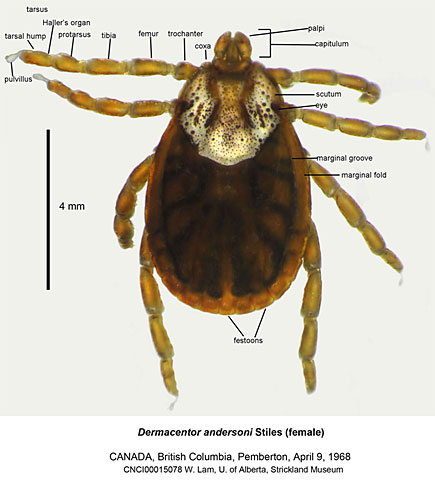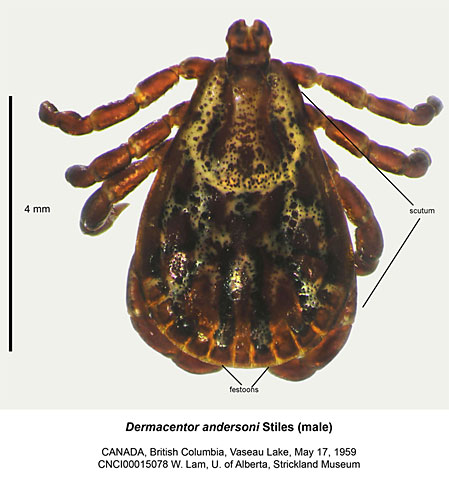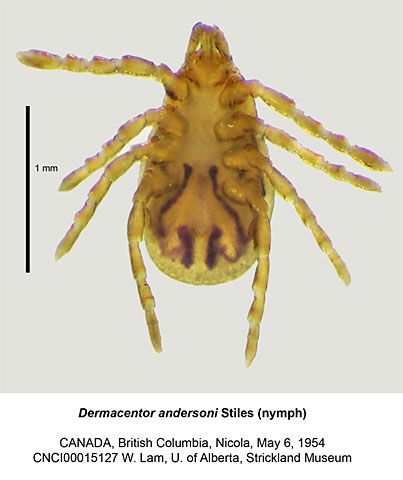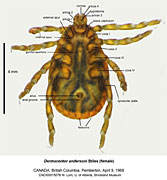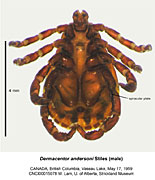« Back to your search
Species Details
Dermacentor andersoni
University of Alberta E.H. Strickland Entomological Museum Read more about this collection »
Common NameRocky Mountain wood tick
SeasonalityMost likely to be encountered, when attached to host, from late February to late summer and early fall.
IdentificationDermacentor andersoni are brown ticks with a light silver-gray ornamentation on the dorsal scutum ('shield"), dorsal portions of the legs and on the basis capitulum ("mouthpart").
Adult female ticks are 2.8 to 5.4 mm long when unengorged and 13.8 mm to 16.5 mm long when engorged. The dorsal scutum ("shield") covers the anterior half of the idiosoma ("body"), while the posterior half of the idiosoma is brown coloured. The spiracular plates are oval shaped and have a long and thin dorsal prolongation.
Adult male ticks are from 2.1 mm to 6.1 mm in length. The scutum covers the entire dorsal surface of the idiosoma. The spiracular plate has a more rounded shape, fewer goblets and a shorter dorsal prolongation than female ticks.
The size and number of goblets on the spiracular plates differentiates the three Dermacentor species in Canada. Dermacentor andersoni have 100- 200 moderately sized goblets, D. albipictus have many large sized goblets, and D. variabilis have more than 300 small goblets. Dermacentor hunteri also has similar-sized and the same number of goblets as D. andersoni. However, D. andersoni is distinguished from D. hunteri by the large and deep punctuations of the scutum. Additionally, D. andersoni has a long and thin dorsal prolongation of their spiracular plates and have a reduced number of goblets near the dorsal prolongation. For both sexes, the goblets of D. andersoni are large in the middle and is surrounded by numerous pore-like structures in the peripheral region.
Scientific Name
Dermacentor andersoni
Common Name
Rocky Mountain wood tick
Habitat
Various habitats where mammalian hosts occur. In Alberta, found in mountane forests and vegetated grasslands.
Seasonality
Most likely to be encountered, when attached to host, from late February to late summer and early fall.
Identification
Dermacentor andersoni are brown ticks with a light silver-gray ornamentation on the dorsal scutum ('shield"), dorsal portions of the legs and on the basis capitulum ("mouthpart").
Adult female ticks are 2.8 to 5.4 mm…
Dermacentor andersoni are brown ticks with a light silver-gray ornamentation on the dorsal scutum ('shield"), dorsal portions of the legs and on the basis capitulum ("mouthpart").
Adult female ticks are 2.8 to 5.4 mm long when unengorged and 13.8 mm to 16.5 mm long when engorged. The dorsal scutum ("shield") covers the anterior half of the idiosoma ("body"), while the posterior half of the idiosoma is brown coloured. The spiracular plates are oval shaped and have a long and thin dorsal prolongation.
Adult male ticks are from 2.1 mm to 6.1 mm in length. The scutum covers the entire dorsal surface of the idiosoma. The spiracular plate has a more rounded shape, fewer goblets and a shorter dorsal prolongation than female ticks.
The size and number of goblets on the spiracular plates differentiates the three Dermacentor species in Canada. Dermacentor andersoni have 100- 200 moderately sized goblets, D. albipictus have many large sized goblets, and D. variabilis have more than 300 small goblets. Dermacentor hunteri also has similar-sized and the same number of goblets as D. andersoni. However, D. andersoni is distinguished from D. hunteri by the large and deep punctuations of the scutum. Additionally, D. andersoni has a long and thin dorsal prolongation of their spiracular plates and have a reduced number of goblets near the dorsal prolongation. For both sexes, the goblets of D. andersoni are large in the middle and is surrounded by numerous pore-like structures in the peripheral region.
Life History
Dermacentor andersoni is a three-host tick, where each life stage (larval, nymph, adult) will take a single blood meal from a different mammalian host. The duration of the life cycle varies and is influenced by…
Dermacentor andersoni is a three-host tick, where each life stage (larval, nymph, adult) will take a single blood meal from a different mammalian host. The duration of the life cycle varies and is influenced by factors such as temperature, humidity, nutrient and host availability. These factors will affect timing and duration of mating, ovipositing, egg hatching, moulting and growth. When raised under ideal laboratory conditions, the life cycle is completed in 68 days; it is longer in the field.
During May to June, the eggs are oviposited on moist vegetation after the engorged female tick drops off the host. The female lays approximately 2500-4000 eggs over 10-33 days. Larval ticks, or "seeds", hatch in early summer and usually remain quiescent for certain length of time. Larvae begin questing for small mammalian hosts, probably from external stimuli such as carbon dioxide, light, temperature or humidity. The stimuli is most likely sensed by the Haller's organ located on the tarsi of leg I. Larvae cling to a passing host with the first pair of legs, will climb upwards and then attach with their gnathostome to the neck or shoulder region. They feed about 2-6 days. After becoming engorged, larvae drop off the host and moult to nymphs. Nymphs remain dormant for extended periods of time unless stimulated by presence of a host. Questing and feeding behaviour are similar to that of larvae.
Females feed continuously throughout their time on the host (5-15 days). Males, on the other hand, feed a shorter period of time and copulate with several, partially fed females that are still on the host. Females drop off the host when fully engorged and seek an area to oviposit. Both sexes die shortly after reproducing.
Similar to most ixodid ticks, all stages of D. andersoni can aestivate for extended periods of time during the summer and will overwinter if unsuccessful in attaching to a host. Typically the life cycle is from 1 to 3 years long. D. andersoni is known as a vector for Rocky Mountain Spotted Fever (Rickettsia rickettsii), tularaemia (.Francisella tularensis) and Colorado tick fever (Colorado tick fever virus). The salivary glands secrete a neurotoxin that can cause tick paralysis on the host on which the tick feeds. Humans are normally attacked by the adult life stage, where the ticks will attach and feed on exposed skin areas of the neck and head region. Nymphs and larvae do not feed on humans. The peak abundance of adult ticks occur in late spring (May to June), but is known to be encountered up to the end of summer and early fall.
Conservation
Dermacentor andersoni is an important pest species as it vectors several disease-causing agents.
Diet Info
All three stages feed on blood of mammalian hosts, however preference of hosts varies between the earlier stages and the adult stage. The adult prefers larger mammals such as humans, dogs, livestock and larger…
All three stages feed on blood of mammalian hosts, however preference of hosts varies between the earlier stages and the adult stage. The adult prefers larger mammals such as humans, dogs, livestock and larger wildlife. Adults will readily feed on humans if encountered. The earlier life stages prefer to attach themselves onto mustelids, hares, rabbits and rodents such as mice, ground squirrels, and voles. Larvae feed for approximately 3 days on a host; nymphs, 6-7 days; and adults, 5-15 days.
Range
Dermacentor andersoni is known to occur from central Saskatchewan to the British Columbia Rocky Mountain range in Canada and in the western United States. In Alberta, D. andersoni is situated more so in the southern…
Dermacentor andersoni is known to occur from central Saskatchewan to the British Columbia Rocky Mountain range in Canada and in the western United States. In Alberta, D. andersoni is situated more so in the southern part of the province and in the Rocky Mountain region.
Notes
Described as Dermacentor andersoni by Stiles in 1908 from a specimen collected from Montana.
Specimen Information
There are 284 specimens of this Species.
DPH1266a - Dermacentor andersoni
University of Alberta E.H. Strickland Entomological Museum
Place CollectedCanada: Alberta, Empress
Collected ByCollins, C. E.
Date Collected1949-06-13
DPH1267a - Dermacentor andersoni
University of Alberta E.H. Strickland Entomological Museum
Place CollectedCanada: Alberta, Empress
Collected ByCollins, C. E.
Date Collected1949-06-14
DPH1270a - Dermacentor andersoni
University of Alberta E.H. Strickland Entomological Museum
Place CollectedCanada: Alberta, Empress
Collected ByCollins, C. E.
Date Collected1949-06-15
DPH1271a - Dermacentor andersoni
University of Alberta E.H. Strickland Entomological Museum
Place CollectedCanada: Alberta, Empress
Collected ByCollins, C. E.
Date Collected1949-06-16
DPH1274a - Dermacentor andersoni
University of Alberta E.H. Strickland Entomological Museum
Place CollectedCanada: Alberta, Lomond
Collected ByCollins, C. E.
Date Collected1949-06-30
DPH1286a - Dermacentor andersoni
University of Alberta E.H. Strickland Entomological Museum
Place CollectedCanada: Alberta, Walsh
Collected ByBrown, D. L.
Date Collected1949-06-08
DPH1287a - Dermacentor andersoni
University of Alberta E.H. Strickland Entomological Museum
Place CollectedCanada: Alberta, Walsh
Collected ByBrown, D. L.
Date Collected1949-06-09
DPH1288a - Dermacentor andersoni
University of Alberta E.H. Strickland Entomological Museum
Place CollectedCanada: Alberta, Brooks
Collected ByBrown, D. L.
Date Collected1949-06-14
DPH1295b - Dermacentor andersoni
University of Alberta E.H. Strickland Entomological Museum
Place CollectedCanada: Alberta, Milo
Collected ByBrown, D. L.
Date Collected1949-06-24
DPH1309a - Dermacentor andersoni
University of Alberta E.H. Strickland Entomological Museum
Place CollectedCanada: Alberta, Cessford
Collected ByBrown, D. L.
Date Collected1949-07-07
DPH1311a - Dermacentor andersoni
University of Alberta E.H. Strickland Entomological Museum
Place CollectedCanada: Alberta, Cessford
Collected ByBrown, D. L.
Date Collected1949-07-07
DPH1314a - Dermacentor andersoni
University of Alberta E.H. Strickland Entomological Museum
Place CollectedCanada: Alberta, Cessford
Collected ByBrown, D. L.
Date Collected1949-07-08
DPH1316a - Dermacentor andersoni
University of Alberta E.H. Strickland Entomological Museum
Place CollectedCanada: Alberta, Hanna
Collected ByBrown, D. L.
Date Collected1949-07-09
DPH1317a - Dermacentor andersoni
University of Alberta E.H. Strickland Entomological Museum
Place CollectedCanada: Alberta, Hanna
Collected ByBrown, D. L.
Date Collected1949-07-09
DPH1320a - Dermacentor andersoni
University of Alberta E.H. Strickland Entomological Museum
Place CollectedCanada: Alberta, Cereal
Collected ByBrown, D. L.
Date Collected1949-07-21
DPH1332a - Dermacentor andersoni
University of Alberta E.H. Strickland Entomological Museum
Place CollectedCanada: Alberta, Hanna
Collected ByCollins, C. E.
Date Collected1949-07-13
DPH1353 - Dermacentor andersoni
University of Alberta E.H. Strickland Entomological Museum
Place CollectedCanada: Alberta, Banff National Park, Banff
Collected ByKamloops lab.
Date Collected1922-05-09
DPH1354 - Dermacentor andersoni
University of Alberta E.H. Strickland Entomological Museum
Place CollectedCanada: Alberta, Banff National Park, Banff
Collected ByKamloops lab.
Date Collected1922-05-17
DPH1355 - Dermacentor andersoni
University of Alberta E.H. Strickland Entomological Museum
Place CollectedCanada: Alberta, Banff National Park, Banff
Collected ByKamloops lab.
Date Collected1924-05-24
DPH1356 - Dermacentor andersoni
University of Alberta E.H. Strickland Entomological Museum
Place CollectedCanada: Alberta, Banff National Park, Banff
Collected ByKamloops lab.
Date Collected1924-05-29
DPH1357 - Dermacentor andersoni
University of Alberta E.H. Strickland Entomological Museum
Place CollectedCanada: Alberta, Banff National Park, Banff
Collected ByKamloops lab.
Date Collected1924-06-04
